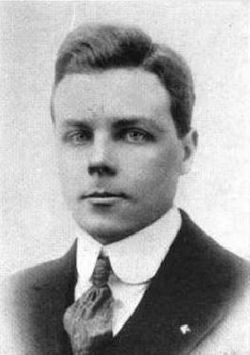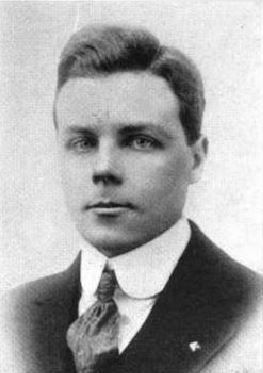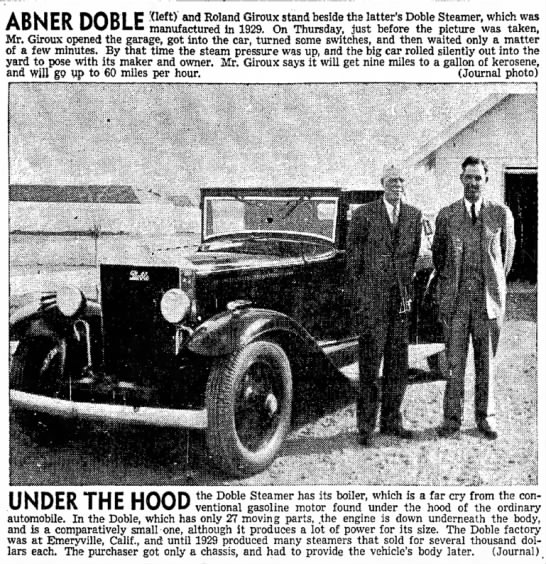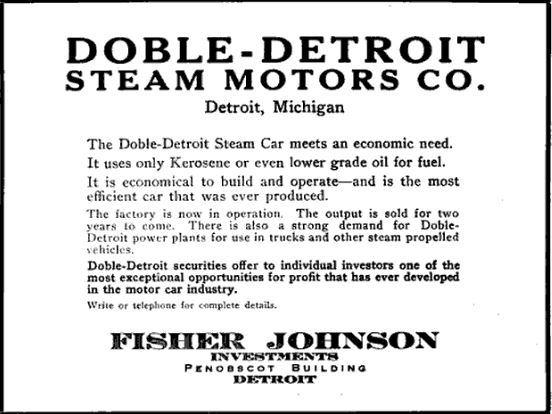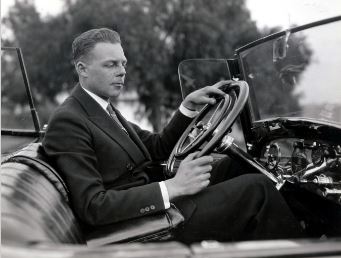In 1915, Abner drove a Model B from Massachusetts to Detroit to seek out investors. He managed to acquire the sum of $200,000.00 which he used to set up the General Engineering Company in Detroit, Michigan. Immediately the Doble brothers began work on their Model C (also known as the Doble Detroit), which was planned to extend and expand upon the innovations pioneered in the Model B. Doble was one of the hundreds of inventors who cast their future with the steam automobile in the early days of automobile manufacturing. The car had only four controls, a steering wheel, a brake pedal, a trip pedal for variable cut-off and reversing, and a foot-operated throttle. The layout of the chassis put the boiler at the front end of the car under the hood, the engine and the rear axle forming an integrated unit. The even weight distribution and low center of gravity contributed much to the ride and handling of all Doble cars. The only defect sometimes noted throughout the Doble car era was less than perfect braking, which was common in automobiles of all types prior to 1930. Typically, a car in the 1920s had only two rear-mounted mechanical drum brakes, although those fitted to Dobles were of larger than usual proportions. Dobles achieved reliability by eliminating most of the mechanical items that tended to malfunction in conventional automobiles. Doble steam cars had no clutch, no transmission, no distributor, and no points. Later Doble steam cars often achieved several hundred thousand miles of use before a major mechanical service was necessary. The Doble Detroit made it's debut at the 1917 New York Motor Show and over 5,000 deposits were received for the car, with deliveries scheduled to begin in early 1918. At the show, Doble announced that he was working on a steam engine for airplanes. However there was one problem, the Doble brothers had not entirely worked out various design and manufacturing issues, and although the car received good notices and several thousand advance orders were placed, very few were actually built, estimates ranging from 11 to as many as 80 (depending on the source). Abner Doble blamed his company's production failure on the steel shortages caused by World War I while buyers and others in the automotive industry felt that the Doble Detroit was mechanically unsatisfactory. Those few customers who had received completed cars complained that they were sluggish and unpredictable, some even reversing when they should have gone forward. In addition, the Doble brothers were divided by Abner's insistence on taking credit for the company's technical achievements, and John Doble ended up suing Abner for patent infringement, whereupon Abner left Detroit for California. John died in 1921 at the age of 28 and after his untimely death, the surviving brothers reunited in Emeryville, California, setting up under the name of Doble Steam Motors in San Francisco. They managed to solve most of the remaining engineering problems and added even more innovations which increased the car's acceleration and reliability. At this time the cars were said to be engineered to perfection and each one went out with a warranty which was rivaled only by Rolls Royce. Between 1921 and 1932, 42 cars were built in the new Emeryville plant and sold for a whopping $10,000.00. The Phaetons were said to weigh as much as 5,000 pounds and could do 100 miles per hour with ease. The cars cruised easily at 75 miles per hour and could start from cold in 15 to 30 seconds. Future billionaire Howard Hughes owned one. Unfortunately, in 1924, the State of California learned that Abner had sold stock illegally in a desperate bid to raise money for the company. In February 1926 he was found guilty by a jury on a charge of violating the state corporate securities act on the sale of $1.7-million dollars in securities by the company however leniency was recommended by the jury. Though Abner was eventually acquitted on a technicality a few months later, the company shuttered for good in 1932 during the ensuing legal struggle and the depths of the Great Depression.
Even though his company failed, Doble went on. He traveled to England, Germany, and New Zealand and worked as a steam power consultant. In 1950 and 51, he continued to develop a steam engine that was meant to surpass internal combustion engines. Ill health forced him to stop active work on the project. He negotiated with a Southern California firm for rights to his invention but the deal fell through and only the dream remained. At the time of his death, Abner was designing a steam car for McCulloch Motors of Los Angeles. No burial services were held, he willed his body to the medical school at the University of California. Inventing was in the family line, his father William and uncle Robert developed the Pelton water wheel, operated by a high-pressure stream of water. He was married twice, first to Helen, they divorced in 1927 and he had three children from that marriage. His second wife was Mildred Alene Doble, she passed away in September 1980. In 1972, Abner Doble was inducted in the Automobile Hall of Fame on the campus of Northwood Institute in Midland, Michigan.
In 1915, Abner drove a Model B from Massachusetts to Detroit to seek out investors. He managed to acquire the sum of $200,000.00 which he used to set up the General Engineering Company in Detroit, Michigan. Immediately the Doble brothers began work on their Model C (also known as the Doble Detroit), which was planned to extend and expand upon the innovations pioneered in the Model B. Doble was one of the hundreds of inventors who cast their future with the steam automobile in the early days of automobile manufacturing. The car had only four controls, a steering wheel, a brake pedal, a trip pedal for variable cut-off and reversing, and a foot-operated throttle. The layout of the chassis put the boiler at the front end of the car under the hood, the engine and the rear axle forming an integrated unit. The even weight distribution and low center of gravity contributed much to the ride and handling of all Doble cars. The only defect sometimes noted throughout the Doble car era was less than perfect braking, which was common in automobiles of all types prior to 1930. Typically, a car in the 1920s had only two rear-mounted mechanical drum brakes, although those fitted to Dobles were of larger than usual proportions. Dobles achieved reliability by eliminating most of the mechanical items that tended to malfunction in conventional automobiles. Doble steam cars had no clutch, no transmission, no distributor, and no points. Later Doble steam cars often achieved several hundred thousand miles of use before a major mechanical service was necessary. The Doble Detroit made it's debut at the 1917 New York Motor Show and over 5,000 deposits were received for the car, with deliveries scheduled to begin in early 1918. At the show, Doble announced that he was working on a steam engine for airplanes. However there was one problem, the Doble brothers had not entirely worked out various design and manufacturing issues, and although the car received good notices and several thousand advance orders were placed, very few were actually built, estimates ranging from 11 to as many as 80 (depending on the source). Abner Doble blamed his company's production failure on the steel shortages caused by World War I while buyers and others in the automotive industry felt that the Doble Detroit was mechanically unsatisfactory. Those few customers who had received completed cars complained that they were sluggish and unpredictable, some even reversing when they should have gone forward. In addition, the Doble brothers were divided by Abner's insistence on taking credit for the company's technical achievements, and John Doble ended up suing Abner for patent infringement, whereupon Abner left Detroit for California. John died in 1921 at the age of 28 and after his untimely death, the surviving brothers reunited in Emeryville, California, setting up under the name of Doble Steam Motors in San Francisco. They managed to solve most of the remaining engineering problems and added even more innovations which increased the car's acceleration and reliability. At this time the cars were said to be engineered to perfection and each one went out with a warranty which was rivaled only by Rolls Royce. Between 1921 and 1932, 42 cars were built in the new Emeryville plant and sold for a whopping $10,000.00. The Phaetons were said to weigh as much as 5,000 pounds and could do 100 miles per hour with ease. The cars cruised easily at 75 miles per hour and could start from cold in 15 to 30 seconds. Future billionaire Howard Hughes owned one. Unfortunately, in 1924, the State of California learned that Abner had sold stock illegally in a desperate bid to raise money for the company. In February 1926 he was found guilty by a jury on a charge of violating the state corporate securities act on the sale of $1.7-million dollars in securities by the company however leniency was recommended by the jury. Though Abner was eventually acquitted on a technicality a few months later, the company shuttered for good in 1932 during the ensuing legal struggle and the depths of the Great Depression.
Even though his company failed, Doble went on. He traveled to England, Germany, and New Zealand and worked as a steam power consultant. In 1950 and 51, he continued to develop a steam engine that was meant to surpass internal combustion engines. Ill health forced him to stop active work on the project. He negotiated with a Southern California firm for rights to his invention but the deal fell through and only the dream remained. At the time of his death, Abner was designing a steam car for McCulloch Motors of Los Angeles. No burial services were held, he willed his body to the medical school at the University of California. Inventing was in the family line, his father William and uncle Robert developed the Pelton water wheel, operated by a high-pressure stream of water. He was married twice, first to Helen, they divorced in 1927 and he had three children from that marriage. His second wife was Mildred Alene Doble, she passed away in September 1980. In 1972, Abner Doble was inducted in the Automobile Hall of Fame on the campus of Northwood Institute in Midland, Michigan.
Gravesite Details
Abner donated his body to medical science. Body donated to medical science and remains returned to the family. Per Contributor: Karl Petersen (47483548)
